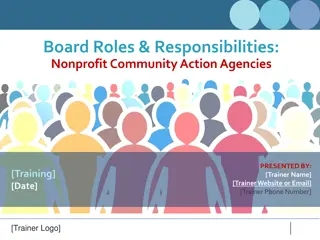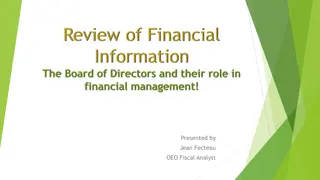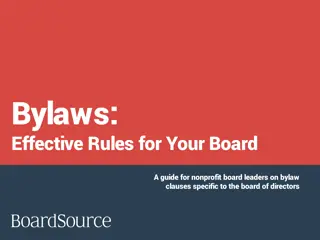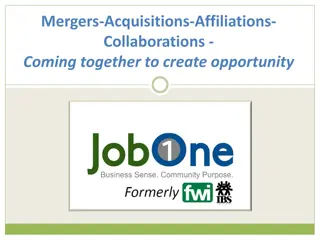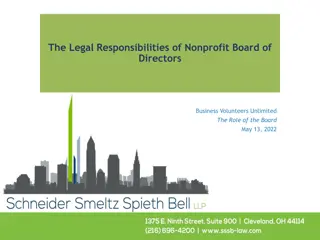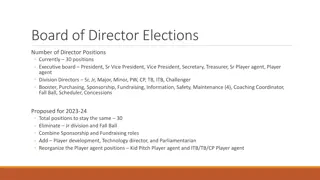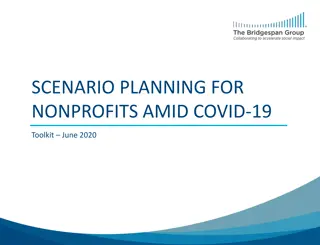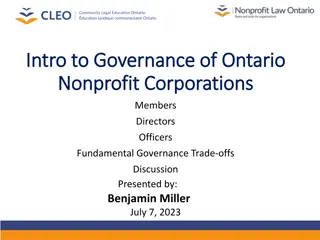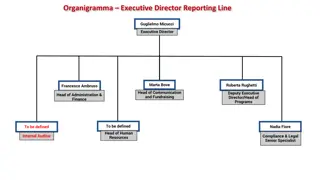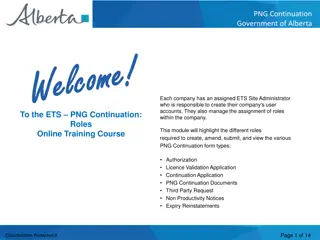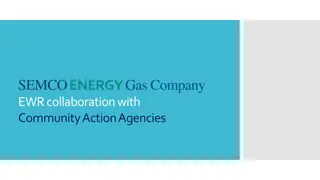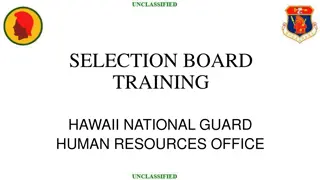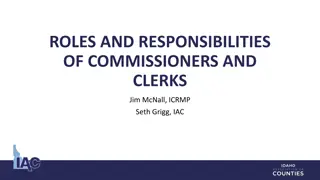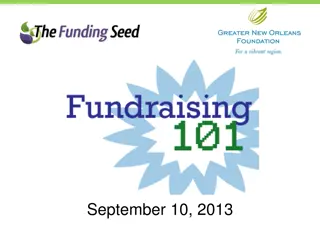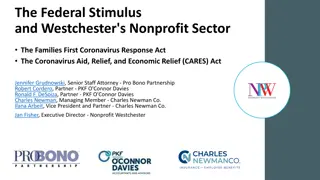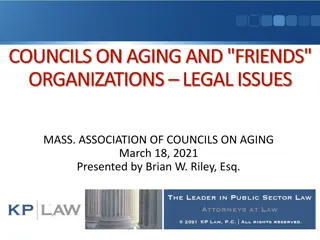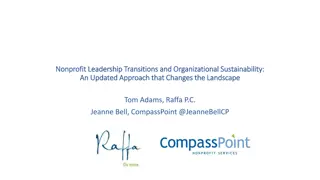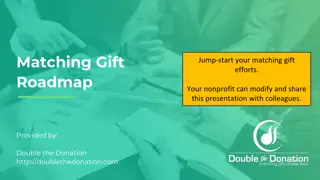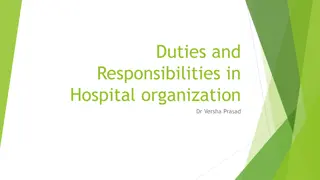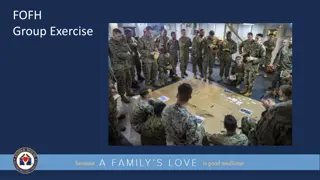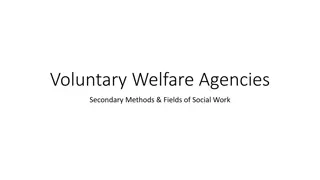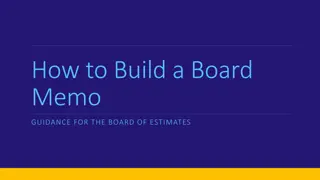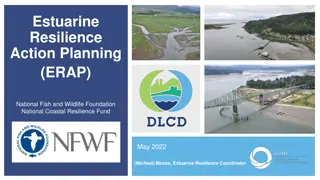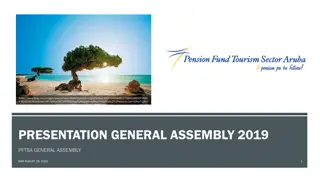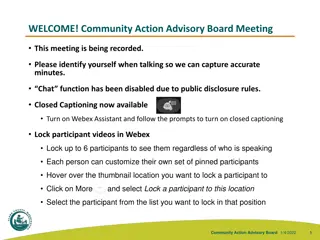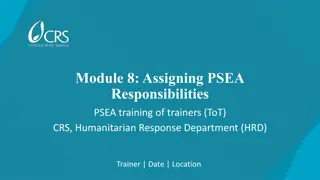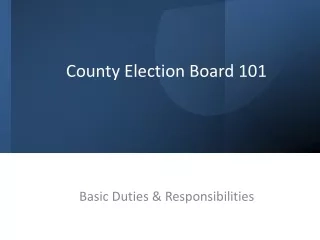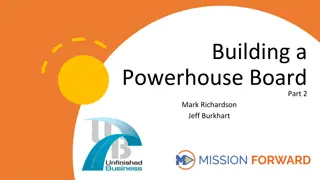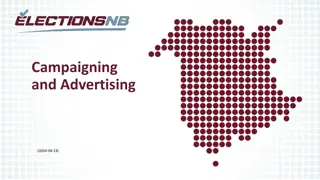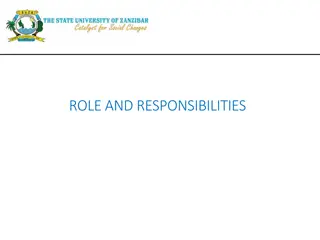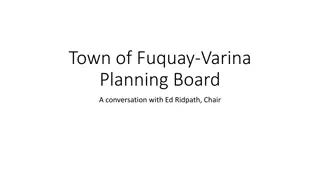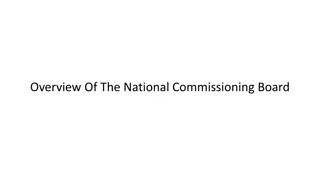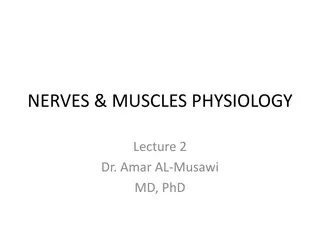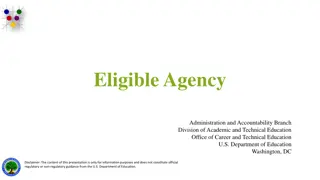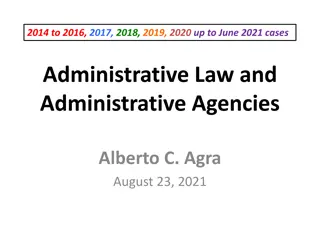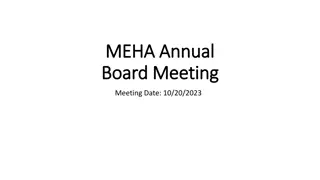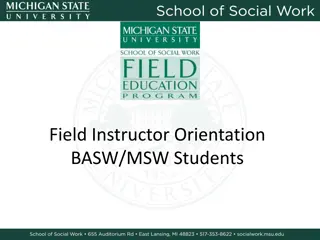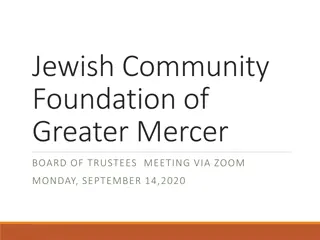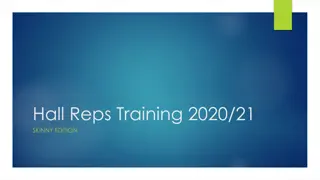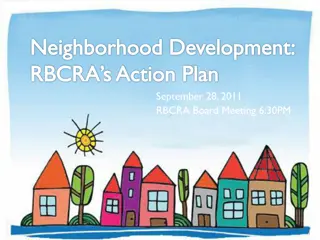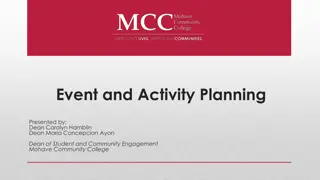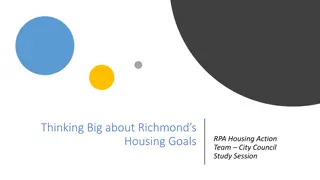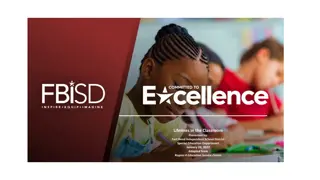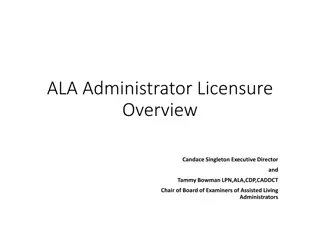Understanding Board Roles and Responsibilities in Nonprofit Community Action Agencies
This presentation provides an in-depth look at the roles and responsibilities of boards in nonprofit community action agencies. Key topics covered include mission planning, engagement, fundraising, performance, and accountability. Participants are guided through exercises to better understand and incorporate their organization's mission into board activities for clarity of purpose and effective decision-making.
Download Presentation

Please find below an Image/Link to download the presentation.
The content on the website is provided AS IS for your information and personal use only. It may not be sold, licensed, or shared on other websites without obtaining consent from the author. Download presentation by click this link. If you encounter any issues during the download, it is possible that the publisher has removed the file from their server.
E N D
Presentation Transcript
Board Roles & Responsibilities: Nonprofit Community Action Agencies PRESENTED BY: [Trainer Name] [Training] [Date] [Trainer Website or Email] [Trainer Phone Number] [Trainer Logo]
This training material was created in collaboration with Community Action Program Legal Services, Inc. (CAPLAW) and the Community Action Partnership (Partnership). The publication was created by National Association of Community Action Agencies - Community Action Partnership in the performance of the U.S. Department of Human Services, Administration for Children and Families, Office of Community Services Grant Number 90ET0465. Any opinion, findings, and conclusions, or recommendations expressed in this material are those of the authors and do not necessarily reflect the views of the U.S. Department of Health and Human Services, Administration for Children and Families. 2
Key Responsibilities of the Tripartite Board 3
Key Board Responsibilities Mission Planning Engagement Generating Funds Performance Accountability 4
Key Board Responsibility Mission 5
Know Your Mission Exercise 1. Write down your organization's mission If you don t know it exactly, write down the gist 2. Briefly describe 3 ways in which your board works with your organization's mission For example, we discuss it in relation to new proposals or recite it at every meeting 3. Think about 1 way in which your board could better incorporate the CAA s mission in its board meetings and activities 6
Why Mission Matters Why mission matters: Provide clarity of purpose to stakeholders Guide major decisions Prevent mission creep Why do you think mission matters? 7
Board Role and Mission Review Update Use Mission 8
Review Mission A good mission statement: Is focused Solves unmet needs Leverages unique skills Inspires key stakeholders / is memorable
Update Mission Producing an effective mission statement often involves: CAPLAW Article Mission Possible: Understanding & Developing an Effective Mission Statement http://caplaw.org/resources/ articlesbytopic/Governance/ CAPLAW_EffectiveMissionS tatement_Fall2010.pdf Commitment from the top Participation by a wide range of stakeholders A well defined revision process Determination of key components Careful crafting active, concise, specific 10
Mission Revision Exercise Your organization has died and at the memorial service for the organization with all of its stakeholders present, a spiritual leader states: Here lies [fill in the organization s name]. It is an organization that was loved and will be missed. It will be remembered forever for:______________. - Dr. Lisa McNary, NCSU 11
Use Mission Ways boards highlight and use the mission: Recite at board meetings Reference in meeting agenda Include on business cards Discuss in relation to all board actions 12
CSBG Organizational Standards Mission CSBG Org. Standard 4.1: Governing board has reviewed the organization s mission statement within the past 5 years and assured that: (1) The mission addresses poverty; and (2) The CAA s programs and services are in alignment with the mission. CSBG Org. Standard 3.1: Organization has conducted a community assessment and issued a report within the past 3 years. CSBG Org. Standard 3.5: Governing board formally accepts the completed community assessment. 13
Key Board Responsibility Planning 14
Planning Exercise Name at least one of each of the following in relation to your CAA: Strength Weakness Opportunity Threat 15
Planning Under CSBG Community Action Plan 3-Year Review (Community needs assessment/CSBG- specific) Strategic Plan 5-Year Review (Organization-wide) 16
Development of Strategic Plan Community Action Partnership & CalCAPA resource available at: https://communityactionpartner ship.com/publication_toolkit/a- comprehensive-guide-to- community-action-strategic- planning-final-5/ 17
A Dual Bottom Line: Mission Impact and Financial Return Impact High Mission Impact High Mission Impact Keep it but contain costs Invest & Grow Low High Profitability Profitability Profitability Close or Give Away Low Mission Impact Low Mission Impact Water, Harvest, & Increase Impact Low High Profitability Profitability $ Source: Nonprofit Sustainability: Making Strategic Decisions for Financial Viability 18
Matrix Map Exercise Keep it but contain costs Invest & Grow Impact ESL 4 classes Head Start preschool U.S. citizenship classes 3 Annual street festival Profitability ($60K) ($40K) ($20K) $20K $40K $60K 2 Annual campaign Quit Smoking classes Water, Harvest, & Increase Impact Close or Give Away 1 $
CSBG Organizational Standards Planning CSBG Org. Standard 6.1: Organization has an agency-wide strategic plan in place that has been approved and accepted by the governing board within the past 5 years. CSBG Org. Standard 3.1: The organization conducted a community assessment and issued a report within the past 3 years. CSBG Org. Standard 3.5: The governing board formally accepts the completed community assessment. 20
Engage in Planning Approaches to help a board meet its planning and strategy development obligations: Form a planning/strategy committee Uses the strategic plan to frame board discussions Use a strategic agenda 21
Strategic Agendas Strike a balance between routine agenda items (e.g., contract approvals etc.) and strategy discussions How will agenda items and information provided to board members help board: Connect with the org s mission Enhance board functioning Provide oversight Identify and make decisions on key issues
Consent Agendas Used for routine, procedural, informational, and self-explanatory non-controversial items Helps streamline meetings If use, should educate board members on: Purpose , i.e., not used to ramrod decisions through Process, i.e., allows for removal of item upon request 23
Strategic Dashboard Income by Type Financial Indicators Last Target This month Last month year end Surplus/(deficit) YTD $270,000 $390,842 $340,908 ($570,240) Income Statement United Way 14% Surplus/(deficit) year-end forecast $270,000 $30,937 $250,987 ($570,240) Program Fees 10% Earned income ratio 11.5% 10.3% 11.8% 13.0% Gov t Grants & Contracts 56% Individual Contributions 4% New grants success ratio 50.0% 35.0% 33.0% 50.0% Corporate/ Foundation Grants 16% Days cash on hand (unrestricted) 45 43 28 51 Balance Sheet Reserve funds balance (1 month payroll) $250,000 $200,000 $150,000 $250,000 Current ratio 2 to 1 5.8 4.2 6.2 Cash Flow AR aged over 90 days 15.0% 22.3% 23.5% 20.0% $800,000 $700,000 Program Indicators $600,000 Last Target This month Last month $500,000 year end Weatherization Contracts (monthly goal) $400,000 20 21 22 15 $300,000 Head Start enrollment 100 60 58 109 Jan Feb Mar Apr May Jun Jul Aug Sep Oct Nov Dec Actual Projected Target = $615,000 minimum Monthly job placements 30 11 14 32 21
Agenda Exercise Describe your CAA s current board meeting agenda List what items on the agenda may be suitable for a consent agenda List the items that require the board to think strategically 26
Key Board Responsibility Engagement 27
Engagement Scenario Jack, a recently retired school superintendent, joined the CAA board 10 years ago and continually gets re-elected to the private sector. He assumes he is on the board because the CAA operates a Head Start program. He is tired of attending community gatherings and interacting regularly with others he did it for over 30 years with his school job. He likes his fellow board members and makes a real effort to attend board meetings focused on early education matters, but doesn t worry if he can t make other meetings. Is Jack an engaged board member? Why or why not? 28
Internal and External Responsibilities With Board/ Organization Engagement With Stakeholders/ Community 29
Ways to INCREASE Engagement Connecting with Community Conducting Assessments Building Relationships Regularly Orienting & Training Strategically Recruiting 30
Board Selection Procedure Use board committee Recruit smartly & strategically Require applications Follow selection procedures 31
Recruitment Matrices Board Source & CAPLAW http://www.caplaw.org/resources/Self AssessmentDocuments/CAPLAW_Boa rdComposition%20Matrix_April2012.x ls https://boardsource.org/bo ard-recruitment-matrix/
Training & Orientation Exercise What Would You Do? List the five most pressing topics for a board member orientation. List the five topics that you think are essential to be covered in board trainings. List three methods for providing training to the board. 33
Training & Orientation Options Use a governance committee to work with executive director and designated staff to: Develop a comprehensive approach Identify topics, e.g., financial oversight, board operations, etc. Establish methods , e.g., webinars, in-person, etc. 34
CSBG Organizational Standards Board Orientation and Training CSBG Org. Standard 5.7 Org. has a process to provide a structured orientation for governing board members within 6 months of being seated. CSBG Org. Standard 5.8 Board members have been provided with training on their duties and responsibilities within the past 2 years. 35
Building Relationships Executive Director and Board Chair Establish expectations Keep communication lines open Frequency of check-ins Regular communication Priorities Identify and work to resolve differences in non-defensive ways Issues to communicate Communications style Sounding board/feedback Ways to support each other 36
Building Relationships Board Members/Executive Director Meet one-on-one with board members Periodic check-ins Provide board members with opportunities to develop their skills as board members Help board members get to know each other Encourage board members to be actively engaged at board meetings 37
Board Assessment Sample Excerpt 38
Board Assessment Process 1. Get your full board on board! 2. Establish a group of board members to oversee the process 3. Administer the assessment tool 4. Tabulate responses 5. Discuss results strengths, weaknesses 6. Establish a realistic action plan 7. Follow up and reassess! 39
Board Assessment Resources Decide on and use appropriate format/tool NH Center for Nonprofits, http://www.nhnonprofits.org/view/member-benefits/256 National Council of Nonprofits, http://www.councilofnonprofits.org/resources/resources- topic/boards-governance/board-member-self-assessment VirtualCAP, http://www.virtualcap.com/downloads/MPI/IN- CAA-Board-Self-Assessment.pdf (tool developed by Indiana Community Action Association) The Nonprofit Association of Oregon, https://nonprofitoregon.org/helpline_resources/Board- Assessment-Tool 40
Connecting with Community Exercise Fill in the Blank Empowering the low-income community Ex., our tripartite board _______________________________ Effectively advocating for the organization and its mission Ex., our tripartite board________________________________ Collecting and providing input on community needs Ex., our tripartite board________________________________ Developing and sustaining strategic partnerships and collaborations Ex., our tripartite board________________________________ 41
CSBG Organizational Standards Community Engagement CSBG Org. Standard 1.1 Organization demonstrates low-income individuals participation in its activities. CSBG Org. Standard 2.1 Organization has documented or demonstrated partnerships across the community, for specifically identified purposes; partnerships include other anti-poverty orgs in the area. CSBG Org. Standard 2.3 Organization communicates its activities and its results to the community. 42
Key Board Responsibility Generating Funds 43
Two Main Ways CAAs Generate Funds * * Fundraising Proposals Soliciting gifts Writing grants Putting on special events Preparing bid proposals Capital campaigns Executive director and staff * Board and executive director * 44
Generating Funds Quiz A CAA cannot rely solely on its state and federal grants and should engage in efforts to generate unrestricted funds. True or False Why? State and federal grants restrict use of funds Diversification of funding often essential for sustainability and flexibility 45
Generating Funds Quiz Generating funds is mainly the executive director s responsibility, not the board s. True or False Why? Joint effort both bring different resources/skills If no unrestricted funds, board must spearhead fundraising efforts 46
Generating Funds Quiz Tripartite boards cannot require members to give financially to the CAA because low-income representatives may be low-income themselves. True or False Why? No legal prohibition against soliciting funds from all board members Allow for varying levels of giving and non-financial ways to give Foundations often want to see 100% board giving 47
Getting Your Board Involved in Fundraising Position your board to fundraise by: Considering fundraising experience/ability when selecting board members Communicating expectation of involvement in fundraising Establishing a board fundraising committee with mix of board members Forming an advisory committee comprised of non- board members with big hearts and deep pockets 48
Oversee Work with staff to develop plan implementation of plan BOARD S ROLEIN FUNDRAISING Identify potential funders Develop & nurture relationships Organize & participate in special events 49
Some Resources Board s Role in Fundraising Grantspace: What is the board s role in fundraising: https://grantspace.org/resources/knowledge-base/boards- and-fundraising/ GIFT Grassroots Institute for Fundraising Training: http://www.grassrootsfundraising.org/ Board Source: books and other resources on nonprofit boards including involving the board in fundraising, https://boardsource.org/fundamental-topics-of-nonprofit- board-service/fundraising/ 50


